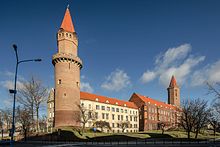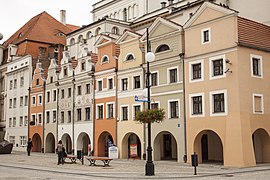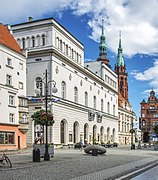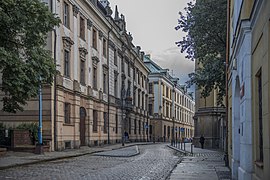Legnica
Legnica | ||
|---|---|---|
| ||
|
Car plates DL | | |
| Highways | ||
| National road | ||
| Website | www.legnica.um.gov.pl | |
Legnica (Polish:
The city was first referenced in chronicles dating from the year 1004,
Legnica became renowned for the fierce battle that took place at Legnickie Pole near the city on 9 April 1241 during the first Mongol invasion of Poland, which ended in the defeat of the Polish-led Christian coalition by the Mongols.
Legnica is an economic, cultural and academic centre in
Population
As of 31 December 2012[update] Legnica has 102,708 inhabitants and is the third largest city in the voivodeship (after Wrocław and Wałbrzych) and 38th in Poland. It also constitutes the southernmost and the largest urban center of a copper deposit (Legnicko-Głogowski Okręg Miedziowy) with agglomeration of 448,617 inhabitants. Legnica is the largest city of the conurbation and is a member of the Association of Polish Cities.
History
Pre-history
Archaeological research conducted in eastern Legnica in the late 1970s, showed the existence of a bronze foundry and the graves of three metallurgists. The find indicates a time interval about year 1000 BC.[8]
A settlement of the
Tacitus and Ptolemy recorded the ancient nation of Lugii (Lygii) in the area, and mentioned their town of Lugidunum, which has been attributed to both Legnica[9] and Głogów.[10]
Early Poland
Slavic Lechitic tribes moved into the area in the 8th century.
The city was first officially mentioned in
Legnica became famous for the

After the war, nonetheless, the city was developing rapidly. In 1258 at the church of St. Peter, a parish school was established, probably the first of its kind in Poland.
Duchy of Legnica

As the capital of the Duchy of Legnica at the beginning of the 14th century, Legnica was one of the most important cities of Central Europe, having a population of nearly 16,000 residents. The city began to expand quickly after the discovery of gold in the Kaczawa River between Legnica and Złotoryja (Goldberg). Unfortunately, such a growth rate can not be maintained long. Shortly after the city reached its maximum population increase, wooden buildings which had been erected during this period of rapid growth were devastated by a huge fire. The fire decreased the number of inhabitants in the city and halted any significant further development for many decades.
Legnica, along with other Silesian duchies, became a vassal of the Kingdom of Bohemia during the 14th century and was included within the multi-ethnic Holy Roman Empire, however remained ruled by local dukes of the Polish Piast dynasty. In 1454, a local rebellion prevented Legnica from falling under direct rule of the Bohemian kings.[18] In 1505, Duke Frederick II of Legnica met in Legnica with the duke of nearby Głogów, Sigismund I the Old, the future king of Poland.[16]


The
In 1668 Duke of Legnica
18th and 19th centuries
Silesian aristocracy was trained at the Liegnitz Ritter-Akademie, established in the early 18th century. One of two main routes connecting Warsaw and Dresden ran through the city in the 18th century and Kings Augustus II the Strong and Augustus III of Poland traveled that route many times.[19] The postal milestone of King Augustus II comes from that period.[20]
In 1742 most of Silesia, including Liegnitz, became part of the

During the
The 20th century

The census of 1910 gave Liegnitz's population as 95.86%

After the defeat of
The city was repopulated with Poles, including expellees from pre-war

The city was only partly damaged in World War II. In June 1945 Legnica was briefly the capital of the Lower Silesian (Wrocław) Voivodship, after the administration was moved there from Trzebnica and before it was finally moved to Wrocław.[30] In 1947, the Municipal Library was opened, in 1948 a piano factory was founded, and in the years 1951-1959 Poland's first copper smelter was built in Legnica.[30] After 1965 most parts of the preserved old town with its town houses were demolished, the historical layout was abolished, and the city was rebuilt in modern form.[31]
From 1945 to 1990, during the
Between 1 June 1975 and 31 December 1998 Legnica was the capital of the Legnica Voivodeship. In 1992 the Roman Catholic Diocese of Legnica was established, Tadeusz Rybak became the first bishop of Legnica.[33] New local newspapers and a radio station were founded in the 1990s.[33] In 1997, Legnica was visited by Pope John Paul II.[33] The city suffered in the 1997 Central European flood.[33]
Climate
Legnica has an oceanic climate (Köppen climate classification: Cfb).[34][35]
| Climate data for Legnica (1991–2020 normals, extremes 1951–present) | |||||||||||||
|---|---|---|---|---|---|---|---|---|---|---|---|---|---|
| Month | Jan | Feb | Mar | Apr | May | Jun | Jul | Aug | Sep | Oct | Nov | Dec | Year |
| Record high °C (°F) | 18.4 (65.1) |
20.0 (68.0) |
24.8 (76.6) |
29.5 (85.1) |
31.4 (88.5) |
36.9 (98.4) |
37.3 (99.1) |
38.4 (101.1) |
35.1 (95.2) |
29.3 (84.7) |
20.6 (69.1) |
18.1 (64.6) |
38.4 (101.1) |
| Mean daily maximum °C (°F) | 3.1 (37.6) |
4.6 (40.3) |
8.9 (48.0) |
15.1 (59.2) |
19.6 (67.3) |
23.0 (73.4) |
25.6 (78.1) |
25.5 (77.9) |
20.0 (68.0) |
14.2 (57.6) |
8.1 (46.6) |
4.2 (39.6) |
14.3 (57.7) |
| Daily mean °C (°F) | 0.2 (32.4) |
1.2 (34.2) |
4.4 (39.9) |
9.5 (49.1) |
13.9 (57.0) |
17.3 (63.1) |
19.5 (67.1) |
19.2 (66.6) |
14.5 (58.1) |
9.7 (49.5) |
4.8 (40.6) |
1.4 (34.5) |
9.6 (49.3) |
| Mean daily minimum °C (°F) | −2.8 (27.0) |
−2.0 (28.4) |
0.5 (32.9) |
3.9 (39.0) |
8.1 (46.6) |
11.6 (52.9) |
13.5 (56.3) |
13.2 (55.8) |
9.6 (49.3) |
5.6 (42.1) |
1.8 (35.2) |
−1.5 (29.3) |
5.1 (41.2) |
| Record low °C (°F) | −27.8 (−18.0) |
−29.7 (−21.5) |
−21.4 (−6.5) |
−7.6 (18.3) |
−2.1 (28.2) |
0.5 (32.9) |
3.4 (38.1) |
3.4 (38.1) |
−3.2 (26.2) |
−6.3 (20.7) |
−16.8 (1.8) |
−24.7 (−12.5) |
−29.7 (−21.5) |
| Average precipitation mm (inches) | 25.0 (0.98) |
22.3 (0.88) |
33.3 (1.31) |
25.9 (1.02) |
57.8 (2.28) |
65.9 (2.59) |
89.6 (3.53) |
64.4 (2.54) |
48.4 (1.91) |
35.7 (1.41) |
28.9 (1.14) |
24.5 (0.96) |
521.6 (20.54) |
| Average extreme snow depth cm (inches) | 4.4 (1.7) |
4.3 (1.7) |
3.2 (1.3) |
0.4 (0.2) |
0.1 (0.0) |
0.0 (0.0) |
0.0 (0.0) |
0.0 (0.0) |
0.0 (0.0) |
0.4 (0.2) |
1.8 (0.7) |
3.1 (1.2) |
4.4 (1.7) |
| Average precipitation days (≥ 0.1 mm) | 15.47 | 13.10 | 14.03 | 10.80 | 13.00 | 13.90 | 13.50 | 11.97 | 11.37 | 12.97 | 13.70 | 14.63 | 158.43 |
| Average snowy days (≥ 0 cm) | 11.6 | 9.2 | 4.3 | 0.4 | 0.1 | 0.0 | 0.0 | 0.0 | 0.0 | 0.2 | 2.7 | 6.6 | 35.1 |
| Average relative humidity (%)
|
83.6 | 80.6 | 76.9 | 70.5 | 72.3 | 72.6 | 70.4 | 70.5 | 77.2 | 81.5 | 86.1 | 84.9 | 77.3 |
| Mean monthly sunshine hours | 58.2 | 81.7 | 126.0 | 196.7 | 238.3 | 237.6 | 249.2 | 242.6 | 162.5 | 119.1 | 66.3 | 53.3 | 1,831.4 |
| Source 1: Institute of Meteorology and Water Management[36][37][38][39][40][41][42][43] | |||||||||||||
| Source 2: Meteomodel.pl (records, relative humidity 1991–2020)[44][45][46] | |||||||||||||
Sights

Legnica is a city with rich historical architecture, ranging from Romanesque and Gothic through the Renaissance and Baroque to Historicist styles. Among the landmarks of Legnica are:
- the Piast Castle, former seat of the local dukes of the Piast dynasty
- Cathedral of Saints Peter and Paul
- Market Square (Rynek) with:
- Baroque Old Town Hall (Stary Ratusz)
- Helena Modrzejewska Theatre
- Kamienice Śledziowe ("Herring Houses")
- Dom Pod Przepiórczym Koszem ("Under the Quail Basket House")
- former Dominican and later Benedictine monastery, founded by Bolesław II the Horned, who was buried there as the only monarch of Poland to be buried in Legnica; nowadays housing the I Liceum Ogólnokształcące im. Tadeusza Kościuszki (high school)
- Saint John the Baptist Church with a mausoleum of the last Piast dukes
- New Town Hall (Nowy Ratusz), seat of city authorities
- Saint Mary church
- Copper Museum (Muzeum Miedzi)
- Medieval Chojnów and Głogów Gates, remnants of the medieval city walls
- Former Knight Academy, now housing municipal offices and a branch of the Copper Museum
- Public Library and archive
- Park Miejski ("City Park"), the oldest and largest park of Legnica
There is also a monument of Pope John Paul II and a postal milestone of King Augustus II the Strong from 1725 in Legnica.[20]
-
Piast Castle courtyard
-
Kamienice Śledziowe at the Market Square
-
Helena Modrzejewska Theatre
-
Saint Mary church
-
Copper Museum
-
Under the Quail Basket House
Economy
In the 1950s and 1960s, the local copper and nickel industries became a major factor in the economic development of the area. Legnica houses industrial plants belonging to KGHM Polska Miedź, one of the largest producers of copper and silver in the world. The company owns a large copper mill on the western outskirts of town. Legnica Special Economic Zone was established in 1997.[47]
Education

Legnica is a regional academic center with seven universities enrolling approximately 16,000 students.
- State-run colleges and universities
- Other
- Wyższa Szkoła Zarządzania / The Polish Open University [4]
- Legnica University of Management [5]
- Wyższe Seminarium Duchowne / Seminary [6]

Environment
Legnica is noted for its parks and gardens, and has seven hundred hectares of green space, mostly along the banks of the Kaczawa; the Tarninow district is particularly attractive.[48]
Roads
To the south of Legnica is the A4 motorway. Legnica has also a district, which is a part of national road no 3. The express road S3 building has been planned nearby.
Public transport

In the city there are 20 regular bus lines, 1
The town has an airport (airport code EPLE) with a 1600-metre runway, the remains of a former Soviet air base, but it is (as of 2007[update]) in a poor state and not used for commercial flights.
Sports
- Miedź Legnica – men's football team (Polish Cup winner 1992; played in the Ekstraklasa in season 2018–19)
Films produced in Legnica
In recent years Legnica has been frequently used as a film set for the following films as a result of its well preserved Old Town, proximity to Germany and low costs:
- Przebacz (dir. M. Stacharski) – 2005
- A Woman in Berlin (dir. M. Färberböck) – 2007
- Wilki (dir. F. Fromm) – 2007
- Little Moscow(dir. W. Krzystek) – 2008
- The Author of Himself: The Life of Marcel Reich-Ranicki (dir. D. Zahavi) – 2008
- Die Wölfe (dir. F. Fromm) – 2009
- Jack Strong (dir. W. Pasikowski) – 2014
Politics
Municipal politics
Legnica tends to be a
Legnica – Jelenia Góra constituency
Members of Parliament (
- Ryszard Bonda, Samoobrona
- Bronisława Kowalska, SLD-UP
- Adam Lipiński, PiS
- Tadeusz Maćkała, PO
- Ryszard Maraszek, SLD-UP
- Olgierd Poniźnik, SLD-UP
- Władysław Rak, SLD-UP
- Tadeusz Samborski, PSL
- Jerzy Szmajdziński, SLD-UP
- Halina Szustak, LPR
- Michał Turkiewicz, SLD-UP
- Ryszard Zbrzyzny, SLD-UP
Notable people


- Henry II the Pious (1196/1207–1241), High Duke of Poland
- Witelo(1230–died 1280–1314), philosopher and scientist
- Bolesław II the Bald(1220–1278), High Duke of Poland
- Hans Aßmann Freiherr von Abschatz (1646–1699), lyricist and translator
- Georg Rudolf Böhmer (1723–1803), physician and botanist
- Johann Wilhelm Ritter (1776–1810), scientist, philosopher, discoverer of ultraviolet radiation
- Heinrich Wilhelm Dove (1803–1879) physicist
- Benjamin Bilse (1816–1902), conductor and composer
- Karl von Vogelsang(1818–1890), Catholic journalist, politician and social reformer
- Leopold Kronecker (1823–1891), mathematician
- Hugo Rühle (1824–1888), physician
- Gustav Winkler (1867–1954), textile manufacturer
- Wilhelm Schubart (1873–1960) classical philologist, historian and papyrologist
- Paul Löbe (1875–1967), social democratic politician
- Erich von Manstein (1887–1973) field marshal
- Gert Jeschonnek (1912–1999), an officer of the Navy, Vice Admiral, Chief of Navy
- Hans-Heinrich Jescheck (1915–2009), jurist
- Günter Reich (1921–1989), opera singer (baritone)
- Claus-Wilhelm Canaris (1937–2021), jurist and legal philosopher
- Uta Zapf (born 1941), politician (SPD), member of the Bundestag from 1990 to 2013
- Anna Dymna (born 1951), TV, film and theatre actress
- Jacek Oleksyn (born 1953), biologist
- Włodzimierz Juszczak (born 1957), bishop of the Eparchy of Wroclaw–Gdansk of the Ukrainian Greek Catholic Church
- Marzena Kipiel-Sztuka (born 1965), actress
- Beata Tadla (born 1975), journalist and TV presenter
- Tomasz Kot (born 1977), actor
- Marek Pająk (born 1977), musician
- Popek (born 1978), rapper and MMA fighter
- Mariusz Lewandowski (born 1979), footballer player
- Aleksandra Klejnowska (born 1982), weightlifter
- Marcin Robak (born 1982), football player
- Jagoda Szmytka (born 1982), composer
- Jakub Popiwczak (born 1996), volleyball player
- Joanna Jarmołowicz (born 1994), actress
- Łukasz Poręba (born 2000), football player
Twin towns – sister cities
In fiction
Legnica and its then ruler Count Conrad figure prominently in the alternate history series The Crosstime Engineer, set in the period of 1230 to 1270, by Leo Frankowski.[citation needed]
References
- ^ a b "Local Data Bank". Statistics Poland. Retrieved 9 August 2022. Data for territorial unit 0262000.
- ^ a b Chisholm, Hugh, ed. (1911). . Encyclopædia Britannica. Vol. 16 (11th ed.). Cambridge University Press. p. 594.
- OCLC 1336402730.
- )
- ^ "*** LEGNICA *** ZAMEK W LEGNICY *** LEGNICA ***". Retrieved 26 March 2017.
- ^ https://www.um.olawa.pl/attachments/article/601/Polish%20Cities%20of%20the%20Future%202015_16.pdf [bare URL PDF]
- ^ "Dolny Śląsk najbogatszy w Polsce, a Wrocław zaraz za Warszawą (RANKING NAJBOGATSZYCH) - Gazetawroclawska.pl". Retrieved 26 March 2017.
- ^ "Brzytwy sprzed 3 tysięcy lat w grobach kowali". 26 December 2016.
- ^ Pierre Deschamps. Dictionnaire de géographie ancienne et moderne. Straubling & Müller, 1922.
- ^ James Cowles Prichard. Researches into the Physical History of Mankind. Sherwood, Gilbert, and Piper. London, 1841.
- ^ "Legnica".
- ^ Korta, Wacław (2013). Historia Śląska do 1763 roku (in Polish). Warsaw: DiG. p. 63.
- ISSN 0066-6041.
- ^ Bar, Joachim Roman (1986). "Polscy święci". Akademia Teologii Katolickiej. 9–10: 36.
- JSTOR 41933117.
- ^ a b c d e f g h i j k l m "Od miasta lokacyjnego do końca czasów piastowskich". Legnica.eu (in Polish). Retrieved 8 November 2019.
- ^ "Królowa z drugiej ligi". Legnica.Gosc.pl (in Polish). 18 January 2018. Retrieved 7 March 2020.
- ^ T. Gumiński, E. Wiśniewski, Legnica. Przewodnik po mieście, Legnica 2001, p. 15.
- ^ "Informacja historyczna". Dresden-Warszawa (in Polish). Retrieved 7 February 2020.
- ^ a b "Legnica - Słup milowy". PolskaNiezwykla.pl (in Polish). Retrieved 7 March 2020.
- ^ "Legnica - Tablica pamiątkowa poświęcona ułanom Legii Nadwiślańskiej". PolskaNiezwykla.pl (in Polish). Retrieved 7 March 2020.
- ^ Sedan 1870. Ryszard Dzieszyńsk, page 52, Bellona 2009
- ^ "Okres rządów hitlerowskich". Legnica.eu (in Polish). Retrieved 8 November 2019.
- ^ Cygański, Mirosław (1984). "Hitlerowskie prześladowania przywódców i aktywu Związków Polaków w Niemczech w latach 1939 - 1945". Przegląd Zachodni (in Polish) (4): 35–36.
- ^ "Gerichtsgefängnis Lignitz". Bundesarchiv.de (in German). Retrieved 29 November 2020.
- ISBN 83-85003-97-5.
- ^ Lusek, Joanna; Goetze, Albrecht (2011). "Stalag VIII A Görlitz. Historia – teraźniejszość – przyszłość". Łambinowicki rocznik muzealny (in Polish). 34. Opole: 44.
- ^ Kubasiewicz, Izabela (2013). "Emigranci z Grecji w Polsce Ludowej. Wybrane aspekty z życia mniejszości". In Dworaczek, Kamil; Kamiński, Łukasz (eds.). Letnia Szkoła Historii Najnowszej 2012. Referaty (in Polish). Warszawa: IPN. p. 117.
- ^ Wala, Grzegorz (9 February 2010). "65. rocznica wyzwolenia Legnicy - foto relacja". Legniczanin.pl (in Polish). Archived from the original on 20 March 2012. Retrieved 26 March 2017.
- ^ a b c "[PRL]" (in Polish). Legnica.eu. Retrieved 8 November 2019.
- ISBN 3-422-03109-X, page 521
- ^ "ARMIA CZERWONA NA DOLNYM ŚLĄSKU" (in Polish). Institute of National Remembrance. Archived from the original on 21 March 2005.
- ^ a b c d "Okres III Rzeczpospolitej". Legnica.eu (in Polish). Retrieved 8 November 2019.
- .
- ISSN 1027-5606.
- ^ "Średnia dobowa temperatura powietrza". Normy klimatyczne 1991-2020 (in Polish). Institute of Meteorology and Water Management. Archived from the original on 3 December 2021. Retrieved 5 February 2022.
- ^ "Średnia minimalna temperatura powietrza". Normy klimatyczne 1991-2020 (in Polish). Institute of Meteorology and Water Management. Archived from the original on 15 January 2022. Retrieved 5 February 2022.
- ^ "Średnia maksymalna temperatura powietrza". Normy klimatyczne 1991-2020 (in Polish). Institute of Meteorology and Water Management. Archived from the original on 15 January 2022. Retrieved 5 February 2022.
- ^ "Miesięczna suma opadu". Normy klimatyczne 1991-2020 (in Polish). Institute of Meteorology and Water Management. Archived from the original on 9 January 2022. Retrieved 5 February 2022.
- ^ "Liczba dni z opadem >= 0,1 mm". Normy klimatyczne 1991-2020 (in Polish). Institute of Meteorology and Water Management. Archived from the original on 15 January 2022. Retrieved 5 February 2022.
- ^ "Średnia grubość pokrywy śnieżnej". Normy klimatyczne 1991-2020 (in Polish). Institute of Meteorology and Water Management. Archived from the original on 15 January 2022. Retrieved 5 February 2022.
- ^ "Liczba dni z pokrywą śnieżna > 0 cm". Normy klimatyczne 1991-2020 (in Polish). Institute of Meteorology and Water Management. Archived from the original on 21 January 2022. Retrieved 5 February 2022.
- ^ "Średnia suma usłonecznienia (h)". Normy klimatyczne 1991-2020 (in Polish). Institute of Meteorology and Water Management. Archived from the original on 15 January 2022. Retrieved 5 February 2022.
- ^ "Legnica Absolutna temperatura maksymalna" (in Polish). Meteomodel.pl. Retrieved 5 February 2022.
- ^ "Legnica Absolutna temperatura minimalna" (in Polish). Meteomodel.pl. Retrieved 5 February 2022.
- ^ "Legnica Średnia wilgotność" (in Polish). Meteomodel.pl. Retrieved 5 February 2022.
- ^ "Legnica Special Economic Zone". Polish Investment and Trade Agency. Retrieved 3 October 2022.
- ^ Legnica: Welcome to Legnica Archived 9 October 2007 at the Wayback Machine
- ^ "Miasta Partnerskie". portal.legnica.eu (in Polish). Legnica. Retrieved 28 February 2020.
External links
- Jewish Community in Legnica on Virtual Shtetl0
- Legnica - Liegnitz, Lignica na portalu polska-org.pl (in Polish)
- Municipal website (in Polish)
- Lca.pl (in Polish)
- City hall (in Polish)
- Legnica (in Polish)













